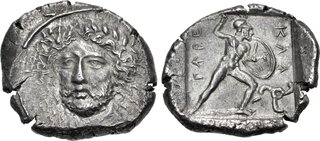| Classical Numismatic Group > Triton XXVII | Auction date: 9 January 2024 |
| Lot number: 299 Price realized: 6,000 USD (Approx. 5,495 EUR) Note: Prices do not include buyer's fees. | Show similar lots on CoinArchives Find similar lots in upcoming auctions on |
| Lot description: DYNASTS of LYCIA. Perikles. Circa 380-360 BC. AR Stater (25mm, 9.77 g, 12h). Struck circa 380-375 BC. Head of Perikles facing slightly left, wearing laurel wreath, drapery around neck / Warrior, nude but for crested Corinthian helmet, in fighting attitude right, holding sword aloft in right hand, shield on left arm; triskeles to lower right, PERI-KLE (in Lycian) around; all within shallow incuse square. Mildenberg, Mithrapata 25 (dies 15/20); Podalia 419–25 (A2/P6); Müseler VII 36 (same obv. die); Falghera –; SNG Copenhagen Supp. 478 (same obv. die); SNG von Aulock 4253 (same obv. die). Toned, typical die wear on obverse. Good VF. Well centered. Ex Dr. G. W. Collection (Gorny & Mosch 269, 9 March 2020), lot 476 (hammer €4600); Classical Numismatic Group 54 (14 June 2000), lot 740. The portraits on coins in the later Lycian series are among the finest of the Classical period. Among the earliest to attempt depictions of their rulers on coinage, the Lycians' first portraits in the later 5th century BC were innovative, but static, idealized forms lacking individual characterization. Over the next half-century, however, the style progressed significantly toward realism, culminating in the issues of the dynasts Mithrapata and Perikles in the early-mid 4th century BC. The coins of Mithrapata came first, depicting on their reverse the profile portrait of a man with distinctive elderly features. Through the relative chronology established in L. Mildenberg's die study, one can even see the portrait become more aged as time progressed, reflecting the realism that had been captured in these issues. The coins of Perikles, Mithrapata's successor, continue this trend, but also have two innovations that set them at the pinnacle of classical portraiture. First, the portrait is moved to the obverse of the coin, emphasizing the importance of the individual. Second, and most prominently, the portrait is not in the traditional profile, but in a dramatic facing state. Obviously influenced by Kimon's facing Arethusa-head coinage at Syracuse, these depict Perikles looking out from the surface of the coin with a serene countenance and his hair flowing around him as if blown by the wind. This depiction captures the essence of the earlier idealized portraits, conveying to the viewer a sense that Perikles was more than a mere man, but retaining the realism in its individualized features. Interestingly, both Mithrapata and Perikles are depicted without any sort of satrapal headgear, which was always included in earlier Lycian portraits, perhaps indicating that they had declared their independence from the Persian king. Unfortunately, these astonishing developments in portraiture came to an abrupt end in Lycia when Maussollos of Caria invaded the region circa 360 BC. Estimate: 3000 USD |  |



